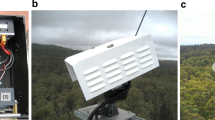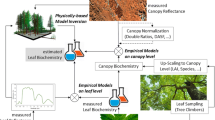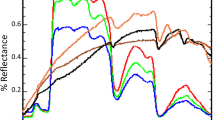Abstract
Imaging spectroscopy is a powerful technique for monitoring the biochemical constituents of vegetation and is critical for understanding the fluxes of carbon and water between the land surface and the atmosphere. However, spectral observations are subject to the sun–observer geometry and canopy structure which impose confounding effects on spectral estimates of leaf pigments. For instance, the sun–observer geometry influences the spectral brightness measured by the sensor. Likewise, when considering pigment distribution at the stand level scale, the pigment content observed from single view angles may not necessarily be representative of stand-level conditions as some constituents vary as a function of the degree of leaf illumination and are therefore not isotropic. As an alternative to mono-angle observations, multi-angular remote sensing can describe the anisotropy of surface reflectance and yield accurate information on canopy structure. These observations can also be used to describe the bi-directional reflectance distribution which then allows the modeling of reflectance independently of the observation geometry. In this paper, we demonstrate a method for estimating pigment contents of chlorophyll and carotenoids continuously over a year from tower-based, multi-angular spectro-radiometer observations. Estimates of chlorophyll and carotenoid content were derived at two flux-tower sites in western Canada. Pigment contents derived from inversion of a CR model (PROSAIL) compared well to those estimated using a semi-analytical approach (r 2 = 0.90 and r 2 = 0.69, P < 0.05 for both sites, respectively). Analysis of the seasonal dynamics indicated that net ecosystem productivity was strongly related to total canopy chlorophyll content at the deciduous site (r 2 = 0.70, P < 0.001), but not at the coniferous site. Similarly, spectral estimates of photosynthetic light-use efficiency showed strong seasonal patterns in the deciduous stand, but not in conifers. We conclude that multi-angular, spectral observations can play a key role in explaining seasonal dynamics of fluxes of carbon and water and provide a valuable addition to flux-tower-based networks.








Similar content being viewed by others
References
Baldocchi DD (2003) Assessing the eddy covariance technique for evaluating carbon dioxide exchange rates of ecosystems: past, present and future. Glob Change Biol 9:479–492
Baldocchi D et al (2001) Fluxnet: a new tool to study the temporal and spatial variability of ecosystem-scale carbon dioxide, water vapor, and energy flux densities. Bull Am Meteorol Soc 82:2415–2434
Baret F, Jacquemoud S, Guyot G, Leprieur C (1992) Modeled analysis of the biophysical nature of spectral shirts and comparison with information content of broad bands. Remote Sens Environ 41:133–142
Barr AG, Black TA, Hogg EH, Kljun N, Morgenstern K, Nesic Z (2004) Inter-annual variability in the leaf area index of a boreal aspen-hazelnut forest in relation to net ecosystem production. Agric For Meteorol 126:237–255
Barr AG et al (2007) Climatic controls on the carbon and water balances of a boreal aspen forest, 1994–2003. Glob Change Biol 13:561–576
Bicheron P, Leroy M (1999) A method of biophysical parameter retrieval at global scale by inversion of a vegetation reflectance model. Remote Sens Environ 67:251–266
Chen J, Leblanc S (1997) A four-scale bidirectional reflectance model based on canopy architecture. IEEE Trans Geosci Remote Sens 35:1316–1337
Chen JM, Liu J, Leblanc SG, Lacaze R, Roujean JL (2003) Multi-angular optical remote sensing for assessing vegetation structure and carbon absorption. Remote Sens Environ 84:516–525
Chen JM, Govind A, Sonnentag O, Zhang YQ, Barr A, Amiro BD (2006) Leaf area index measurements at Fluxnet-Canada forest sites. Agric For Meteorol 140:257–268
Coleman TF, Li YY (1996) An interior trust region approach for nonlinear minimization subject to bounds. SIAM J Optim 6:418–445
Coleman TF, Liu JG, Yuan W (2002) A new trust-region algorithm for equality constrained optimization. Comput Optim Appl 21:177–199
Damm A et al (2010) Remote sensing of sun-induced fluorescence to improve modeling of diurnal courses of gross primary production (GPP). Glob Change Biol 16:171–186
Field C, Chapin F III, Matson P, Mooney H (1992) Responses of terrestrial ecosystems to the changing atmosphere: a resource-based approach. Annu Rev Ecol Syst 23:201–235
Filella I, Porcar-Castell A, Munne-Bosch S, Back J, Garbulsky MF, Penuelas J (2009) PRI assessment of long-term changes in carotenoids/chlorophyll ratio and short-term changes in de-epoxidation state of the xanthophyll cycle. Int J Remote Sens 30:4443–4455
Gamon JA, Penuelas J, Field CB (1992) A narrow-waveband spectral index that tracks diurnal changes in photosynthetic efficiency. Remote Sens Environ 41:35–44
Gamon JA, Filella I, Penuelas J (eds) (1993) The dynamic 531-nanometer reflectance signal: a survey of twenty angiosperm species. American Society of Plant Physiologists, Rockville
Gao W, Schaaf CB (2003) Detecting vegetation structure using a kernel-based BRDF model. Remote Sens Environ 86:198–205
Gitelson AA, Buschmann C, Lichtenthaler HK (1999) The chlorophyll fluorescence ratio F-735/F-700 as an accurate measure of the chlorophyll content in plants. Remote Sens Environ 69:296–302
Gitelson AA, Gritz Y, Merzlyak MN (2003) Relationships between leaf chlorophyll content and spectral reflectance and algorithms for non-destructive chlorophyll assessment in higher plant leaves. J Plant Physiol 160:271–282
Gitelson AA, Vina A, Ciganda V, Rundquist DC, Arkebauer TJ (2005) Remote estimation of canopy chlorophyll content in crops. Geophys Res Lett 32
Gitelson AA et al (2006) Relationship between gross primary production and chlorophyll content in crops: implications for the synoptic monitoring of vegetation productivity. J Geophys Res Atmos 111:1–13
Goel NS, Strebel DE (1983) Inverstion of vegetation canopy reflectance models for estimating agronomic variables. 1. Problem definition and initial results using the suits model. Remote Sens Environ 13:487–507
Goel NS, Thompson RL (1984) Inverstion of vegetation canopy reflectance models for estimating agronomic variables. 4. Total inversion of the SAIL model. Remote Sens Environ 15:237–253
Hall FG, Townshend JR, Engman ET (1995) Status of remote-sensing algorithms for estimation of land-surface state parameters. Remote Sens Environ 51:138–156
Hall FG et al (2008) Multi-angle remote sensing of forest light use efficiency by observing PRI variation with canopy shadow fraction. Remote Sen Environ 112:3201–3211
Hilker T, Coops NC, Nesic Z, Wulder MA, Black AT (2007) Instrumentation and approach for unattended year round tower-based measurements of spectral reflectance. Comput Electron Agric 56:72–84
Hilker T et al (2008) Separating physiologically and directionally induced changes in PRI using BRDF models. Remote Sens Environ 112:2777–2788
Hilker T et al (2010a) Remote sensing of photosynthetic light-use efficiency across two forested biomes: spatial scaling. Remote Sens Environ 114:2863–2874
Hilker T, Nesic Z, Coops NC, Lessard D (2010b) A new, automated, multi-angular radiometer instrument for tower-based observation of canopy reflectance (AMSPEC II). Instrum Sci Technol 38:319
Humphreys ER et al (2006) Carbon dioxide fluxes in coastal douglas-fir stands at different stages of development after clearcut harvesting. Agric For Meteorol 140:6–22
Jacquemoud S, Bacour C, Poilve H, Frangi JP (2000) Comparison of four radiative transfer models to simulate plant canopies reflectance: direct and inverse mode. Remote Sens Environ 74:471–481
Jacquemoud S et al (2009) PROSPECT plus SAIL models: a review of use for vegetation characterization. Remote Sens Environ 113:S56–S66
Jassal RS et al (2007) Components of ecosystem respiration and an estimate of net primary productivity of an intermediate-aged douglas-fir stand. Agric For Meteorol 144:44–57
Kempeneers P et al (2008) Model inversion for chlorophyll estimation in open canopies from hyperspectral imagery. Int J Remote Sens 29:5093–5111
Kuusk A (1998) Monitoring of vegetation parameters on large areas by the inversion of a canopy reflectance model. Int J Remote Sens 19:2893–2905
Lewandowska M, Jarvis PG (1977) Changes in chlorophyll and carotenoid content, specific leaf area and dry-weight fraction in sitka spruce, in response to shading and season. New Phytol 79:247–256
Li XW, Strahler AH (1985) Geometric-optical modeling of a conifer forest canopy. IEEE Trans Geosci Remote Sens 23:705–721
Los SO, North PRJ, Grey WMF, Barnsley MJ (2005) A method to convert AVHRR normalized difference vegetation index time series to a standard viewing and illumination geometry. Remote Sens Environ 99:400–411
Lowman M, D’Avanzo C, Brewer C (2009) A national ecological network for research and education. Science 323:1172–1173
Matsubara S et al (2008) Lutein epoxide cycle, light harvesting and photoprotection in species of the tropical tree genus Inga. Plant Cell Environ 31:548–561
Meroni M, Colombo R, Panigada C (2004) Inversion of a radiative transfer model with hyperspectral observations for Lai mapping in poplar plantations. Remote Sens Environ 92:195–206
Merzlyak MN, Gitelson AA, Chivkunova OB, Solovchenko AE, Pogosyan SI (2003) Application of reflectance spectroscopy for analysis of higher plant pigments. Russ J Plant Physiol 50:704–710
Monteith JL (1972) Solar-radiation and productivity in tropical ecosystems. J Appl Ecol 9:747–766
Monteith JL (1977) Climate and efficiency of crop production in Britain. Philos Trans R Soc Lond B 281:277–294
Morgenstern K et al (2004) Sensitivity and uncertainty of the carbon balance of a pacific northwest douglas-fir forest during an El Nino La Nina cycle. Agric For Meteorol 123:201–219
Myneni R, Hall F, Sellers P, Marshak A (1995) The interpretation of spectral vegetation indexes. IEEE Trans Geosci Remote Sens 33:481–486
Ozanne CMP et al (2003) Biodiversity meets the atmosphere: a global view of forest canopies. Science 301:183–186
Price J (1992) Estimating vegetation amount from visible and near infrared reflectances. Remote Sens Environ 41:29–34
Privette JL, Emery WJ, Schimel DS (1996) Inversion of a vegetation reflectance model with NOAA AVHRR data. Remote Sens Environ 58:187–200
Richardson AD, Jenkins JP, Braswell BH, Hollinger DY, Ollinger SV, Smith ML (2007) Use of digital webcam images to track spring green-up in a deciduous broadleaf forest. Oecologia 152:323–334
Richardson AD, Hollinger DY, Dail DB, Lee JT, Munger JW, O’Keefe J (2009) Influence of spring phenology on seasonal and annual carbon balance in two contrasting New England forests. Tree Physiol 29:321–331
Ross JK (1981) The radiation regime and architecture of plant stands. Junk, The Hague
Roujean JL, Leroy M, Deschamps PY (1992) A bidirectional reflectance model of the earths surface for the correction of remote-sensing data. J Geophys Res Atmos 97:20455–20468
Ruimy A, Jarvis PG, Baldocchi DD, Saugier B (1995) CO2 flux over plant canopies and solar radiation: a review. Adv Ecol Res 26:1–63
Sellers P et al (1995) The Boreal Ecosystem-Atmosphere Study (BOREAS): an overview and early results from the 1994 field year. Bull Am Meteorol Soc 76:1549–1577
Sims DA, Gamon JA (2002) Relationships between leaf pigment content and spectral reflectance across a wide range of species, leaf structures and developmental stages. Remote Sens Environ 81:337–354
Stylinski CD, Gamon JA, Oechel WC (2002) Seasonal patterns of reflectance indices, carotenoid pigments and photosynthesis of evergreen chaparral species. Oecologia 131:366–374
Suits GH (1972) The calculation of the directional reflectance of a vegetative canopy. Remote Sens Environ 2:117–125
Tanja S et al (2003) Air temperature triggers the recovery of evergreen boreal forest photosynthesis in spring. Glob Change Biol 9:1410–1426
Ustin SL et al (2009) Retrieval of foliar information about plant pigment systems from high resolution spectroscopy. Remote Sens Environ 113:S67–S77
Verhoef W (1984) Light scattering by leaf layers with application to canopy reflectance modeling: the SAIL model. Remote Sens Environ 16:125–141
Verrelst J, Schaepman ME, Koetz B, Kneubuhler M (2008) Angular sensitivity analysis of vegetation indices derived from CHRIS/PROBA data. Remote Sens Environ 112:2341–2353
Verstraete MM, Pinty B (2001) Introduction to special section: modeling, measurement, and exploitation of anisotropy in the radiation field. J Geophys Res Atmos 106:11903–11907
Verstraete MM, Pinty B, Myneni RB (1996) Potential and limitations of information extraction on the terrestrial biosphere from satellite remote sensing. Remote Sens Environ 58:201–214
Wanner W, Li X, Strahler A (1995) On the derivation of kernels for kernel-driven models of bidirectional reflectance. J Geophys Res 100:21077–21089
Weiss M, Baret F, Myneni RB, Pragnere A, Knyazikhin Y (2000) Investigation of a model inversion technique to estimate canopy biophysical variables from spectral and directional reflectance data. Agronomie 20:3–22
Yoder B, Waring R (1994) The normalized difference vegetation index of small douglas-fir canopies with varying chlorophyll concentrations. Remote Sens Environ 49:81–91
Zarco-Tejada PJ, Miller JR, Morales A, Berjon A, Aguera J (2004) Hyperspectral indices and model simulation for chlorophyll estimation in open-canopy tree crops. Remote Sens Environ 90:463–476
Zhang QY et al (2006) Characterization of seasonal variation of forest canopy in a temperate deciduous broadleaf forest, using daily MODIS data. Remote Sens Environ 105:189–203
Zhang YQ, Chen JM, Thomas SC (2007) Retrieving seasonal variation in chlorophyll content of overstory and understory sugar maple leaves from leaf-level hyperspectral data. Can J Remote Sens 33:406–415
Zhang YQ, Chen JM, Miller JR, Noland TL (2008) Leaf chlorophyll content retrieval from airborne hyperspectral remote sensing imagery. Remote Sens Environ 112:3234–3247
Acknowledgments
Thank you to Zoran Nesic, Dominic Lessard, Andrew Hum and Rick Ketler from UBC Faculty of Land and Food Systems (LFS) for their assistance in technical design, installation, and maintenance of AMSPEC II. This research is partially funded by the Canadian Carbon Program, the Natural Sciences and Engineering Research Council of Canada (NSERC) and BIOCAP, and an NSERC-Accelerator grant to Dr. Coops.
Author information
Authors and Affiliations
Corresponding author
Additional information
Communicated by Gerardo Avalos.
Rights and permissions
About this article
Cite this article
Hilker, T., Gitelson, A., Coops, N.C. et al. Tracking plant physiological properties from multi-angular tower-based remote sensing. Oecologia 165, 865–876 (2011). https://doi.org/10.1007/s00442-010-1901-0
Received:
Accepted:
Published:
Issue Date:
DOI: https://doi.org/10.1007/s00442-010-1901-0




